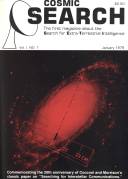![[NAAPO Logo]](../../Images/NAAPOsm.jpg) North American AstroPhysical Observatory (NAAPO)
|
|
Editorial: Science and The Multitudes
By: Richard Berendzen
Decades ago, C. P. Snow said that the multitudes had about as much communication with M.I.T. as though the scientists spoke nothing but Tibetan." Despite the vast funding spent on innovative educational projects during the past twenty years, the situation probably has only worsened since Snow. Scientific knowledge has increased exponentially while public understanding of science has grown linearly at best. While new scientific discoveries flooded in, universities reduced broadening requirements, schools at all levels lessened standards, and the public bewildered by a complex world, lost faith in technology and blamed science. How lamentable in the short span of life to know only about man and virtually nothing about the world. How preposterously arrogant. How chauvinistically egocentric.
Tragically, one of the most important contributors to the sad state of society's scientific intellect has been higher education itself. In our recent genuine zeal for educational reform, grieviously overdue, we often have failed shamefully to maintain, much less enhance, the academic standards that produced our modern world. Like a thunderous juggernaut, whose inertia resists motion but whose momentum becomes colossal, higher education in the 1960's began to swing, crushing much before it, both good and ill. Out went universities' insensitivity to teaching effectiveness, but also out went many professors' rigor. Out went truly irrelevant curricula, but also out went parts of the core of civilized thought. Out went oppressive general education requirements, but also out went the unparalleled richness of a liberal and liberating education.
While our nation lands on Mars, delves into the gene, sweeps Nobel prizes for 1976 (all accomplishments made by graduates of another era), our recent educational system has produced a generation bordering on functional illiteracy. In no area has this been more the case than in scientific understanding by non-science students.
And earlier generations of non-scientists often seem scarcely better informed. Receptions, even those frequented by academic literati and industrial tycoons, give the astronomer pause, for inevitably he will be asked, "Can you guess people's astrological signs?" (Probably, about one time in twelve.) "Don't you think Velikovsky is brilliant?" (Yes, he sold many books.) "Why did They place the Bermuda Triangle in the ocean?" (So that ships and planes would disappear, not cars and trains.) "Why do the Air Force and NASA conspire to hide the awful truth about UFO's?" (To keep their budgets modest.) "What did ancient astronauts teach Peruvian Indians?" (Not law or medicine, but how to draw giant beetles.)
Why this public fascination with the exotic and the pseudo-scientific, especially when the world of circumstance is infinitely more subtle and surprising? The popular, mystical theories are necessarily limited by human imagination, whereas the Universe itself, as J.B.S. Haldane put it, is not queerer than we suppose but queerer than we can suppose.
Our current students need to experience Close Encounters of at least three kinds — with logic, with math, and with science. If presented well, science fact can be far more engaging than science fiction; moreover, as Carl Sagan has noted, it has the additional value of being true.
Or at least it constitutes our current understanding of truth. Actually, scientific "facts" themselves evolve, changing as our information and insights improve. Contrary to frequent popular opinion, science is not merely a body of codified absolutes, immutably fixed; rather, it is a dynamic venture, possessing all the strengths and weaknesses, logical or illogical, that typify any human enterprise.
"Students need to experience Close Encounters of at least three kinds — with logic, with math and with science."
But, in truth, it must be conceded that science and scientists themselves deserve much of the blame for the current public level of scientific understanding. Ironically, as modern astronomy has brought forth some of the most mind-boggling concepts ever encountered (e.g., pulsars, starquakes, black holes, worm holes, quasars, primordial collapsars), the esoteric yet plausible has sounded increasingly like the bizarre and pseudo-scientific, particularly to non-specialists. And surely no topic possesses that duality — of solid, cutting edge science vs. tawdry mysticism and charlatanry — more than does the search for extraterrestrial life. Should scientists be surprised or offended when the public confuses respectable 21 centimeter searches with disreputable UFO accounts, particularly when the media widely and uncritically advertise the latter? Surely scientists, perhaps especially astronomers with their unusually high level of per capita Federal funding, owe a debt to the public that supports them, to explain the differences between findings and fads and to share with the widest possible audience what we know of nature's beauty. And given the lamentable current state of public scientific literacy, this responsibility has never been greater.
Richard Berendzen
Member, Editorial Board of COSMIC SEARCH
|
